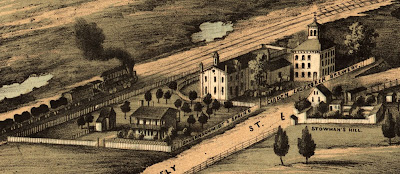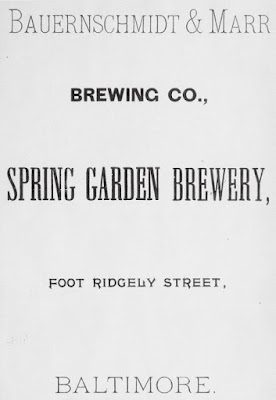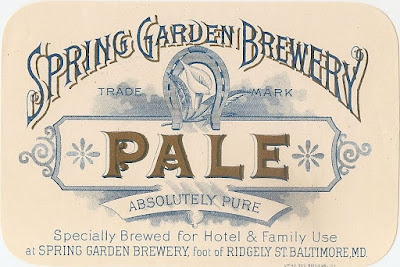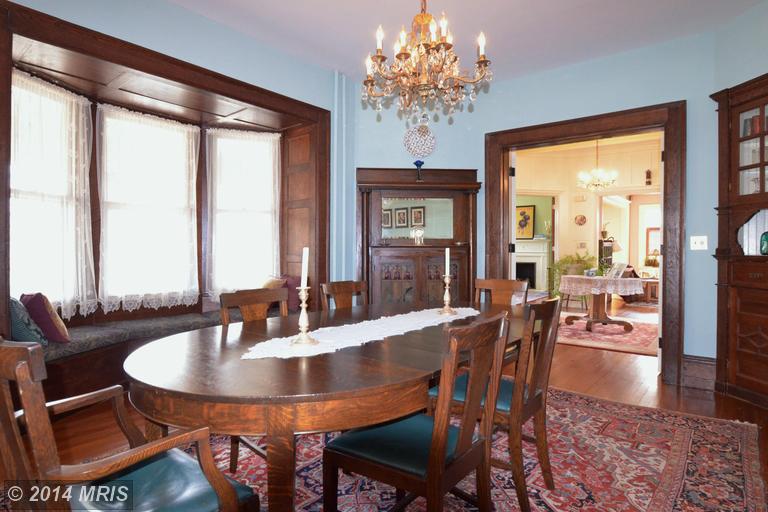There is no doubt that there is some Christmas album out there for everyone and every taste. Some are classics, some are trendy, and some are downright awful... and some are magnificent...
Founded in Cambridge, Massachusetts in 1971, the Revels are now in nine additional cities, all producing The Christmas Revels, in addition to other programs.
The original performance was recorded and is now available on CD. This was the original medieval Christmas Revels which started this 40+ year tradition. Stereo Review called it "The best Christmas record I can think of..." The Washington Post said it was "A simple, revealing album that will last through many winters." And The Boston Phoenix called it "A joyous reminder of what the season is all about."
It might not be for everyone, but I find peace in the music in a season obscured by commercialism and a frantic pace from which we could all use and enjoy an escape. So take time out this Christmas season and relax for a bit while enjoying this holiday classic.
All Rights Reserved.
Monday, December 12, 2016
Wednesday, July 27, 2016
Before the Ban Part 2 - Pre-Prohibition Baltimore Breweries - The August Beck/Frank Steil Brewery
Now long forgotten to history, Baltimore was once a major brewing city with over 45 breweries operating at one time. In this series, I hope to bring to life this long lost history.
The August Beck's Lager Beer Brewery was established on Garrison Road, now South Franklintown Road by August Beck in 1861.
Beck was born in 1821 in Rottenburg, Wurtenburg and was married to Frederica Beck.
Employing 12-15 men, in 1878 the brewery sold 7,706 barrels of beer and in 1879 it sold 6,935 barrels of beer.

In 1881 the brewery was sold to August Beck, son of the founder.
John Marr, formerly of Bauernschmidt & Marr, bought the brewery in 1899 to run it as John Marr's Independent Brewery, under the management of Frank Steil. The brewery went bankrupt and in December 1900 was purchased by Steil, operating under the name of the Frank Steil Brewing Company. As of 1911 it had 1-65 ton and 1-40 ton York compression ice making machines made by the York Manufacturing Company of York, Pennsylvania, and direct expansion refrigerating system. In 1913, Steil added a 45'x46' bottling house designed by George Repp.
With prohibition, the brewery was converted into a slaughter house and meat packing plant.
The August Beck's Lager Beer Brewery was established on Garrison Road, now South Franklintown Road by August Beck in 1861.
August Beck's Lager Beer Brewery 1869
Beck was born in 1821 in Rottenburg, Wurtenburg and was married to Frederica Beck.
1887 Advertisement
By the time of Beck's death in 1880, the brewery complex consisted of a number of buldings. There was a recently built 40'x40' dwelling house with a mansard roof and a two story 24'x24' brick back building which served as the residence of August Beck. There was a two story brick 40'x140' beer brewery, beer cellar, engine house, office and ice house. Just north of Beck's dwelling house was a two story brick house which was used as a dwelling house and a beer saloon. Behind this was a 24'x120' two story brick building used as a stable and adjoining this was a 24'x70' brick wagon shed. At the rear of the property was a 40'x95' large frame "sommerhaus" built for and used as a beer and concert hall. Also on the property was a brick stable for cows, a small frame cooper shop and an open frame shed. The brewery itself contained 8 large fermenting tubs of 300 barrels each and 16 fermenting tubs of 600 barrels each, 2 maish tubs, 2 large copper kettles and a beer cooler. There was also four large double and three single beer wagons. The brewery had the capacity to produce 10,000 to 12,000 barrels of beer per year.

1888 Advertisement
In 1881 the brewery was sold to August Beck, son of the founder.
John Marr, formerly of Bauernschmidt & Marr, bought the brewery in 1899 to run it as John Marr's Independent Brewery, under the management of Frank Steil. The brewery went bankrupt and in December 1900 was purchased by Steil, operating under the name of the Frank Steil Brewing Company. As of 1911 it had 1-65 ton and 1-40 ton York compression ice making machines made by the York Manufacturing Company of York, Pennsylvania, and direct expansion refrigerating system. In 1913, Steil added a 45'x46' bottling house designed by George Repp.
With prohibition, the brewery was converted into a slaughter house and meat packing plant.
1908 Advertisement
Some of the brewery survives today. The most obvious survivor is the former house of August Beck built in 1875. The two story beer saloon and the row of buildings behind it were torn down sometime between 1983 and 2016. As late as 1983 the beer cellars below this row of buildings survived, but it is unknown if they survived the demolition of the buildings themselves. The brewhouse itself burned in 1969 and has been replaced by a more recent structure.
A. Beck's Brewery 1890
200 South Franklintown Road
Frank Steil Brewing Company (formerly A. Beck's Brewery) 1901
200 South Franklintown Road
Frank Steil Brewing Company (formerly A. Beck's Brewery) 1914
200 South Franklintown Road
All Rights Reserved.
Wednesday, July 13, 2016
Before the Ban Part 1 - Pre-Prohibition Baltimore Breweries - The Bauernschmidt & Marr Spring Garden Brewery
Now long forgotten to history, Baltimore was once a major brewing city with over 45 breweries operating at one time. In this series, I hope to bring to life this long lost history.
The Spring Garden Brewery was established on Stowman's Hill by John Jacob Bauernschmidt in 1859 as John Bauernschmidt's Lager Brewery. Bauernschmidt was born in 1830 in Wambach, Bavaria and was married to Elizabeth Marr Bauernschmidt. Bauernschmidt enlarged the brewery several times, adding a saloon and inn before his death in 1879. The brewery originally featured wood fired copper kettles and cypress wash tubs. In 1878 the brewery sold 12,017 barrels of beer and in 1879 it sold 10,037 barrels of beer.
After Bauernschmidt's death, his wife's brother, John Marr, joined the brewery operating as Bauernschmidt & Marr. In November 1884, Bauernschmidt & Marr received a builing permit to build 2 two-story brick buildings at the brewery site.
Elizabeth Bauernschmidt died in 1886 and the brewery was purchased in 1889 by British interests. Marr continued to manage the brewery under the name Bauernschmidt & Marr's Spring Garden Brewery.
The name of the brewery changed again in 1892, now known as Baltimore Breweries Company Ltd.'s Spring Garden Brewery.
Today parts of the brewery still remain. Bauernschmidt's house, which also some of his workers, was built in the early 1870's, but was torn down some time between 1980 and 2016. It was a three and a half story, almost cubical, brick house, five bays wide on all sides, with a hipped roof. Marr lived in this house until at least 1890. By 1901 the first floor was being used for bottling with lodging rooms above.
A 14 bay long brick bottling plant still lies along Ridgely Street. It appears that the brew house also survives on this site.
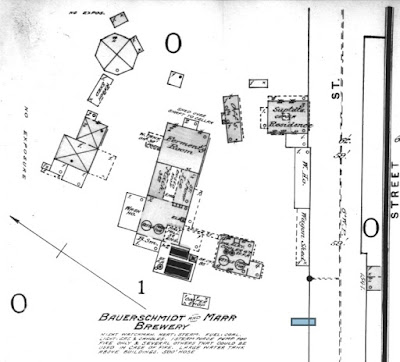

All Rights Reserved.
The Spring Garden Brewery was established on Stowman's Hill by John Jacob Bauernschmidt in 1859 as John Bauernschmidt's Lager Brewery. Bauernschmidt was born in 1830 in Wambach, Bavaria and was married to Elizabeth Marr Bauernschmidt. Bauernschmidt enlarged the brewery several times, adding a saloon and inn before his death in 1879. The brewery originally featured wood fired copper kettles and cypress wash tubs. In 1878 the brewery sold 12,017 barrels of beer and in 1879 it sold 10,037 barrels of beer.
John Bauernschmidt's Lager Beer Brewery 1869
Bird's Eye View of John Bauernschmidt's Lager Beer Brewery 1869
After Bauernschmidt's death, his wife's brother, John Marr, joined the brewery operating as Bauernschmidt & Marr. In November 1884, Bauernschmidt & Marr received a builing permit to build 2 two-story brick buildings at the brewery site.
Elizabeth Bauernschmidt died in 1886 and the brewery was purchased in 1889 by British interests. Marr continued to manage the brewery under the name Bauernschmidt & Marr's Spring Garden Brewery.
Baltimore American News 1886 Advertisement
The name of the brewery changed again in 1892, now known as Baltimore Breweries Company Ltd.'s Spring Garden Brewery.
Baltimore American News 1894 Advertisement
In 1902 it was purchased by Frank Steil Brewing Company, becoming its Spring Garden Brewery. In 1903 the brewery closed, and was purchased in 1905 by the Mount Vernon Brewing Company of New Jersey, reopening in 1906 as the Mount Vernon Brewery. They built a 72'x40' one story bottling plant along Ridgely Street in 1905 built by B.W. &E. Minor and designed by W.L. Minor. The brewery fell into receivership and was sold to L.F. Ruth, R. Marietta and Clair Stellwagon. In 1908 the brewery was bought by Conrad Eurich, but it went into receivership that same year and closed for good in 1909. While in operation as Eurich, their Pilsner was 5.25% alcohol as of November 2, 1908. Then in 1909 the brewery was sold Gustav A. Bachman who planned to open the site as the Consumers Brewing Company of Baltimore City. In 1911 it was again sold at a receivers sale. At this time it had 1-25 ton and 1-30 ton Consolidated compression ice making machines made by the Modern Steel Structural Company of Waukesha, Wisconsin, and 1-100 ton De La Vergne compression ice making machine made by the De La Vergne Machine Company of New York. In 1912, Joseph H. Straus and Alexander L. Straus were rumored to buy the Mount Vernon Brewery to operate it as an independent brewery, but they bought the Standard Brewery instead.
Today parts of the brewery still remain. Bauernschmidt's house, which also some of his workers, was built in the early 1870's, but was torn down some time between 1980 and 2016. It was a three and a half story, almost cubical, brick house, five bays wide on all sides, with a hipped roof. Marr lived in this house until at least 1890. By 1901 the first floor was being used for bottling with lodging rooms above.
A 14 bay long brick bottling plant still lies along Ridgely Street. It appears that the brew house also survives on this site.

Bauerschmidt and Marr Brewery 1890
1500 Ridgely Street

Spring Garden Brewery (formerly the Bauerschmidt and Marr Brewery) 1901
1500 Ridgely Street
Site of the Mt. Vernon Brewing Company (formerly the Spring Garden Brewery) 1914
1500 Ridgely Street
All Rights Reserved.
Monday, June 27, 2016
Crowning The Gravelly Hill... Part 11
Part eleven of the series...
Designed by W.L. Price of Philadelphia and built by the Roland Park Company between 1893 and May 1896.
The views show a design appropriate to its surroundings, the broad treatment of the roof and gable ends being the principal features of the design. There is a wide, well shaded porch, with square columns on stone piers, supporting the high hipped and overhanging gable roofs. The foundation and a portion of the first story, as well as the main chimney of rock-faced local stone, laid with joints well broken and with good color effect. The other chimneys of is brick, and stone capped. All exterior framework is sheathed, covered with building paper, shingled, and originally stained deep red. The roof was originally similarly treated. Dimensions: Front, 31'3", exclusive of bay; side, 62'7", not including porch projections. Heights: Cellar, 7'6"; first story, 9'; second, 8'6"; attic, 7'6".
The reception hall, running full width of the house and finished in red oak, has a wide arched opening, forming a separating feature from the staircase portion, with the fireplace centered, and faced with tiles, a mantel over.
There is wide staircase of easy rise, with turned balusters and plain square newel, and a leaded landing window. The walls were originally papered.
The parlor also has a tiled (angle) fireplace, with a mantel of neat design above, and connects by pocket doors.
Dining room, finished natural, has double sliding door opening, bay full width, and connects with kitchen, containing usual fixtures, through pantry, provided with dressers, sink, etc.
There is a large linen closet, provided with shelves, etc. The attic has a servant's rooms and storage space. The cellar is cemented, and is provided with heating apparatus, fuel storage space, etc.
All Rights Reserved.
Residence of Harry Billington Rosston - 318 Woodlawn Road
Designed by W.L. Price of Philadelphia and built by the Roland Park Company between 1893 and May 1896.
The views show a design appropriate to its surroundings, the broad treatment of the roof and gable ends being the principal features of the design. There is a wide, well shaded porch, with square columns on stone piers, supporting the high hipped and overhanging gable roofs. The foundation and a portion of the first story, as well as the main chimney of rock-faced local stone, laid with joints well broken and with good color effect. The other chimneys of is brick, and stone capped. All exterior framework is sheathed, covered with building paper, shingled, and originally stained deep red. The roof was originally similarly treated. Dimensions: Front, 31'3", exclusive of bay; side, 62'7", not including porch projections. Heights: Cellar, 7'6"; first story, 9'; second, 8'6"; attic, 7'6".
The reception hall, running full width of the house and finished in red oak, has a wide arched opening, forming a separating feature from the staircase portion, with the fireplace centered, and faced with tiles, a mantel over.
Reception Hall looking into the Parlor ahead and Reception room to right 2015
There is wide staircase of easy rise, with turned balusters and plain square newel, and a leaded landing window. The walls were originally papered.
The parlor also has a tiled (angle) fireplace, with a mantel of neat design above, and connects by pocket doors.
Parlor 2015
Dining room, finished natural, has double sliding door opening, bay full width, and connects with kitchen, containing usual fixtures, through pantry, provided with dressers, sink, etc.
Dining Room 2015
Kitchen 2015
The laundry in rear has three wash trays. The second floor is divided into four chambers, the connecting one intended for a dressing room, and a bathroom with the plumbing exposed and with approved fixtures.
Principal Chamber over parlor 2015
Bedroom over kitchen 2015
Bedroom over kitchen 2015
Bathroom 2015
There is a large linen closet, provided with shelves, etc. The attic has a servant's rooms and storage space. The cellar is cemented, and is provided with heating apparatus, fuel storage space, etc.
All Rights Reserved.
Friday, June 24, 2016
Crowning The Gravelly Hill... Part 10
Part ten of the series...
Designed by Wyatt & Nolting of Baltimore and built between 1893 and May 1896.
McPherson was one of the original members of the Baltimore Country Club.
This country house represents a Colonial residence, embracing both symmetry of design and convenience of arrangement. The piazza is cozily sheltered and of inviting appearance, with Tuscan columns and pilaster at shingled jambs. The bay at side gives ease to and relieves the severity of roof lines. Shingles on roof were originally weathered, and on the side originally stained snuff brown. The trimmings were originally of cream color, contrasted by dark green shutters. The chimney is of red brick, with bluestone coping. Dimensions: Front, exclusive of bay, 30'2"; side, 51'4". Heights: Cellar, 8'6"; first story, 10'3"; second, 9'7"; attic, 7'6". On the first floor we have an attractive reception hall, paneled in cypress. The staircase has spindle balusters reaching to the under side of a flat arch adorning the ceiling. The angle fireplace is paneled. The back stairs are conveniently connecting with the main staircase at the landing. The library contains an angular fireplace, with a marble mantel supported by two brackets. The dining room was originally in white, with an ornamental frieze, ans also contains a cheerful fireplace of neat design. The kitchen and pantry are each provided with a dresser with drawers under shelves. In attic there is one large bedroom, a servant's bedroom, and convenient storage accommodations.
All Rights Reserved.
Country House of John W. McPherson, Esq. - 415 Hawthorne Road
Designed by Wyatt & Nolting of Baltimore and built between 1893 and May 1896.
McPherson was one of the original members of the Baltimore Country Club.
This country house represents a Colonial residence, embracing both symmetry of design and convenience of arrangement. The piazza is cozily sheltered and of inviting appearance, with Tuscan columns and pilaster at shingled jambs. The bay at side gives ease to and relieves the severity of roof lines. Shingles on roof were originally weathered, and on the side originally stained snuff brown. The trimmings were originally of cream color, contrasted by dark green shutters. The chimney is of red brick, with bluestone coping. Dimensions: Front, exclusive of bay, 30'2"; side, 51'4". Heights: Cellar, 8'6"; first story, 10'3"; second, 9'7"; attic, 7'6". On the first floor we have an attractive reception hall, paneled in cypress. The staircase has spindle balusters reaching to the under side of a flat arch adorning the ceiling. The angle fireplace is paneled. The back stairs are conveniently connecting with the main staircase at the landing. The library contains an angular fireplace, with a marble mantel supported by two brackets. The dining room was originally in white, with an ornamental frieze, ans also contains a cheerful fireplace of neat design. The kitchen and pantry are each provided with a dresser with drawers under shelves. In attic there is one large bedroom, a servant's bedroom, and convenient storage accommodations.
All Rights Reserved.
Thursday, June 23, 2016
Crowning The Gravelly Hill... Part 9
Part nine of the series...
Designed by the owner James F. Leib of Baltimore and built between June 1893 and May 1896.
On June 23, 1893 Leib purchased this lot for $1500 from the Roland Park Company.
He was one of the original members of the Baltimore Country Club and an 1890 graduate of the Mechanical Division of the Maryland Institute College of Art.
The views show a front piazza, with four stone piers to the height of rail, forming base for square columns supporting the overhanging gable roof, which is relieved by the wide, hipped-roof dormers in front and rear. The foundation and piers are of local stone. The structure above is sheathed, papered, clapboarded, and was originally painted yellow at the first story. The gable is shingled and was originally stained brown. The roof was also originally shingled, and left to weather. The chimneys are of brick, and capped with stone. Dimensions: Front, 29', exclusive of entrance porch; side, 40', including piazza. Height: Cellar, 6'6"; first story, 9'; second, 8'6"; attic, 7'. The entrance porch is at the side, with the door opening on the hall, in white pine, and grained oak. The staircase has wide newels, with paneled faces and a flat cap. The turned balusters are on a straight string. A pocket door opens on the music room, in pine, was painted white, with an angle fireplace, faced with light gray mottled tiles. The mantel, also painted, has an ornamental top and beveled mirror. The library connects by pocket doors. It has a similar fireplace, with tiles of light mottled brown, and mantel above, and is backed with a mirror. This room also has a glazed door to front piazza, and really serves purpose of reception hall or living room. The dining room has a fireplace, also tiled. The upper mantelshelf is supported by two long fluted columns. Two shorter ones support the side shelves. A beveled mirror is at the head. A passage, with a pantry at the side, leads to the kitchen. A wide, circular arch, with a large, central electric light globe, forms an interesting feature in the second floor hall. This floor is divided off into four chambers of good size, two with alcoves (circular plaster arches), and all with large closets. There is also a bathroom, wainscoted in yellow pine, natural. All the plumbing being exposed and nickel-plated, a tub of enameled iron, and a basin of marble. All of these were of the best make. There are two rooms in attic. The house is trimmed throughout in white pine, grained or painted, lighted by electricity and gas, heated by hot air and cost complete $3500; The cellar is cemented, and contains the heater, fuel storage, etc.
All Rights Reserved.
Cottage of James F. Leib, Esq. - 502 Woodlawn Road
Designed by the owner James F. Leib of Baltimore and built between June 1893 and May 1896.
On June 23, 1893 Leib purchased this lot for $1500 from the Roland Park Company.
He was one of the original members of the Baltimore Country Club and an 1890 graduate of the Mechanical Division of the Maryland Institute College of Art.
The views show a front piazza, with four stone piers to the height of rail, forming base for square columns supporting the overhanging gable roof, which is relieved by the wide, hipped-roof dormers in front and rear. The foundation and piers are of local stone. The structure above is sheathed, papered, clapboarded, and was originally painted yellow at the first story. The gable is shingled and was originally stained brown. The roof was also originally shingled, and left to weather. The chimneys are of brick, and capped with stone. Dimensions: Front, 29', exclusive of entrance porch; side, 40', including piazza. Height: Cellar, 6'6"; first story, 9'; second, 8'6"; attic, 7'. The entrance porch is at the side, with the door opening on the hall, in white pine, and grained oak. The staircase has wide newels, with paneled faces and a flat cap. The turned balusters are on a straight string. A pocket door opens on the music room, in pine, was painted white, with an angle fireplace, faced with light gray mottled tiles. The mantel, also painted, has an ornamental top and beveled mirror. The library connects by pocket doors. It has a similar fireplace, with tiles of light mottled brown, and mantel above, and is backed with a mirror. This room also has a glazed door to front piazza, and really serves purpose of reception hall or living room. The dining room has a fireplace, also tiled. The upper mantelshelf is supported by two long fluted columns. Two shorter ones support the side shelves. A beveled mirror is at the head. A passage, with a pantry at the side, leads to the kitchen. A wide, circular arch, with a large, central electric light globe, forms an interesting feature in the second floor hall. This floor is divided off into four chambers of good size, two with alcoves (circular plaster arches), and all with large closets. There is also a bathroom, wainscoted in yellow pine, natural. All the plumbing being exposed and nickel-plated, a tub of enameled iron, and a basin of marble. All of these were of the best make. There are two rooms in attic. The house is trimmed throughout in white pine, grained or painted, lighted by electricity and gas, heated by hot air and cost complete $3500; The cellar is cemented, and contains the heater, fuel storage, etc.
All Rights Reserved.
Wednesday, June 22, 2016
Crowning The Gravelly Hill... Part 8
Part eight of the series...
Residence of Moses B. Sayre, Esq. - 311 Oakdale Road
Designed by W.L. Price of Philadelphia and built between Fall 1891 and May 1896.
Sayre was proprietor of the Sayre Optical Company. He was also one of the original members of the Baltimore Country Club.
The design is domestic gothic in feeling, the octagonal tower breaking through the great expanse of the gable roof, well shaded porch, roof being supported by stone piers, hipped entrance feature and general grouping of windows, are the principal exterior features. The foundation and first story are of rock faced, light gray stone. The exterior framework above is sheathed, papered, shingled, and was originally stained deep red. The roof was also shingled and originally left to weather. the trimming color was originally cream. The shutters at the stone work, were originally the same. The other shutters were originally painted green. The chimneys are of red brick, with recessed face, and corbeled top. Dimensions: Front, 57'6"; side, 36', not including bay or porch projections. Height: Cellar, 7'6"; first story, 9'; second, 8'6"; attic, 7'6".
The floor plans show a most convenient arrangement of rooms. The entrance door, with sash above, and paneled beneath, leads to a vestibule, having seat at one side, and door to reception hall, which is wainscoted, with the ceiling plastered and paneled off, beams being exposed. There is a square column at stairs, with a beam forming a flat arch over the inglenook. The fireplace is faced with light buff brick, with a mantel shelf above, and is paneled to the ceiling. There are seats at each side.
Reception Hall in 2014 Showing Inglenook and Seats
View from Reception Hall towards the Library in 2014
Reception Hall in 2014
The reception room in the tower, is octagonal in form, and is in pine, originally painted cream. There is a low paneled wainscot or dado. The fireplace is faced with cream tiles, and has a Colonial style mantel above.
Reception Room in 2014
The library, originally in dark oak and now painted white, has a fireplace, faced with large burnt Sienna tiles, a mantel above, and is paneled to the ceiling. There is a seat at one angle, and a closet in the other. There is a seat at the mullioned window. There was a beam over the bookcases (now removed) at the blank wall.
Library in 2014
Library in 2014
Library in 2014
The dining room, also in oak, has a seat in the bay window, a fireplace faced with blue tiles, and a shelf and dresser above in one angle, with a china closet in other.
Dining Room in 2014 showing the china closet in the corner
Dining Room in 2014
Dining Room in 2014
The butler's pantry originally had a generous dresser room, sink and shelves, but was removed to expand the kitchen. The kitchen contained the usual fixtures.
Kitchen in 2014. The area beyond the ceiling beam was the former butler's pantry.
Kitchen in 2014. The area beyond the ceiling beam was the former butler's pantry.
Kitchen in 2014
Kitchen in 2014. The area beyond the ceiling beam was the former butler's pantry.
Kitchen in 2014
The second floor is divided into four chambers, all with large closets, a sewing and two bath rooms, with best fixtures and exposed plumbing.
Stairway from Second Floor in 2014
Chamber above Dining Room in 2014
Chamber above Dining Room in 2014
Bathroom above former Butler's Pantry in 2014
Chamber above Kitchen in 2014
Chamber above Reception Room in 2014
Bathroom above Inglenook in 2014
Chamber above Library in 2014
A servant's apartment and storage space are in attic.
Attic in 2014
Attic in 2014
The cellar is cemented, and contains the laundry, heating apparatus, fuel storage, and other apartments.
All Rights Reserved.
Subscribe to:
Posts (Atom)










